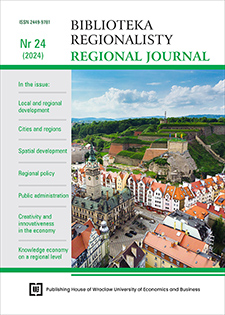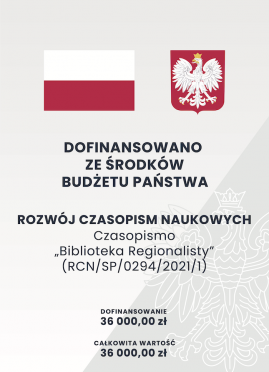Renewable energy transition in Europe in the last two decades
DOI:
https://doi.org/10.15611/br.2024.1.03Keywords:
sustainable development, renewable energy sources, share of renewable energyAbstract
Aim: The article aims to explore the evolution of the share of renewable energy in selected European countries over the period from 2005 to 2022 by examining countries with varying levels of renewable energy penetration and highlight regional disparities in renewable energy growth.
Methods: This study uses quantitative analysis of Eurostat’s energy data to examine the share of renewable energy in total final consumption across European countries in 2005, 2012, and 2022. Descriptive statistics, comparisons, and trend analysis are supported by visualizations, including maps, bar, and line charts, to illustrate changes over time.
Results: The results reveal substantial progress in renewable energy adoption across Europe between 2005 and 2022, with notable variability in growth rates between countries, underscoring both the successes and the challenges faced in achieving energy transition.
Implications and recommendations: The findings highlight the need for targeted policies and support mechanisms to assist countries with slower renewable energy adoption, particularly in addressing economic constraints and structural barriers that hinder progress.
Originality/value: This study provides a comprehensive analysis of renewable energy growth across Europe from 2005 to 2022, offering unique insights into regional disparities and the factors contributing to the varying pace of renewable energy adoption.
Downloads
References
Atici, C. (2009). Carbon emissions in Central and Eastern Europe: environmental Kuznets curve and implications for sustainable development. Sustainable Development, 17(3), 155-160. https://doi.org/10.1002/sd.372
Communication from the Commission to the European Parliament, the European Council, the Council, the European Economic and Social Committee and the Committee of the Regions The European Green Deal. (COM(2019) 640 final, 11.12.2019). https://eur-lex.europa.eu/legal-content/EN/TXT/?uri=CELEX:52019DC0640
Dizdaroglu, D. (2019). Measuring residential sustainability performance: An indexing approach. International Journal of Sustainable Development, 22(1-2), 1-23. https://doi.org/10.1504/IJSD.2019.104717
European Commission/Eurostat. (2019). Sustainable development in the European Union: Monitoring report on progress towards the SDGs in an EU context: 2019 edition. Publications Office. https://data.europa.eu/doi/10.2785/44964
Eurostat. (n.d.). Database. Retrieved August 21, 2024, from https://ec.europa.eu/eurostat/data/database
Fischer, J., Helman, K., Kramulová, J., Petkovová, L., & Zeman, J. (2013). Sustainable development indicators at the regional level in the Czech Republic. Statistika, 93(1), 5-19.
Herrmann, M. (2014). The challenge of sustainable development and the imperative of green and inclusive economic growth. Modern Economy, 5(2), 113-119. https://doi.org/10.4236/me.2014.52013
Hlaváček, P., Skalník, V. (2021). The implementation of smart energy into transformation of the rural area: The use of public policies for smart villages development. International Journal of Energy Economics and Policy, 11(4), 1-6. https://doi.org/10.32479/ijeep.11203
Joseph, C., Gunawan, J., Madi, N., Janggu, T., Rahmat, M., & Mohamed, N. (2019). Realising sustainable development goals via online integrity framework disclosure: Evidence from Malaysian and Indonesian local authorities. Journal of Cleaner Production, 215, 112-122. https://doi.org/10.1016/J.JCLEPRO.2019.01.057
Lazaretti, K., Giotto, O. T., Sehnem, S., & Bencke, F. F. (2019). Building sustainability and innovation in organizations. Benchmarking. An International Journal, 27(7), 2166-2188. https://doi.org/10.1108/BIJ-08-2018-0254
Manolis, E. N., & Manoli, E. N. (2021). Raising awareness of the Sustainable Development Goals through Ecological Projects in Higher Education. Journal of Cleaner Production, 279, Article 123614. https://doi.org/10.1016/j.jclepro.2020.123614
Megyesiova, S., & Lieskovska, V. (2018). Analysis of the sustainable development indicators in the OECD countries. Sustainability, 10(12), Article 4554. https://doi.org/10.3390/su10124554
Pilewicz, T., & Derlukiewicz, N., Mempel-Śnieżyk. A., & Zdon-Korzeniowska, M. (2018). Entrepreneurial activity, market orientation, investment attractiveness and transaction costs for enterprises in local development context. Barometr
Regionalny. Regional Barometer, 16(3), 109-119. https://doi.org/10.56583/br.356
Regulation (EU) 2021/1119 of the European Parliament and of the Council of 30 June 2021 establishing the framework for achieving climate neutrality and amending Regulations (EC) No 401/2009 and (EU) 2018/1999 (‘European Climate Law’) (Official Journal of the European Union, L 243, 9.7.2021, 1–17). https://eur-lex.europa.eu/eli/reg/2021/1119/oj/eng
Robert, K. W., Parris, T. M., & Leiserowitz, A. A. (2005). What is sustainable development? Goals, indicators, values, and practice. Environment: Science and Policy for Sustainable Development. 47(3), 8-21. https://doi.org/10.1080/00139157.2005.10524444
Rusak, H. (2009). Energetyka odnawialna w świetle wskaźników zrównoważonego rozwoju systemów energetycznych . Prace Naukowe Uniwersytetu Ekonomicznego we Wrocławiu, (83), 31-39.
World Bank. (2012.) Inclusive green growth: The pathway to sustainable development. Washington, DC. http://hdl.handle.net/10986/6058
Downloads
Published
Issue
Section
License
Copyright (c) 2025 Anna Mempel-Śnieżyk

This work is licensed under a Creative Commons Attribution-ShareAlike 4.0 International License.
Accepted 2025-01-14
Published 2025-01-31







